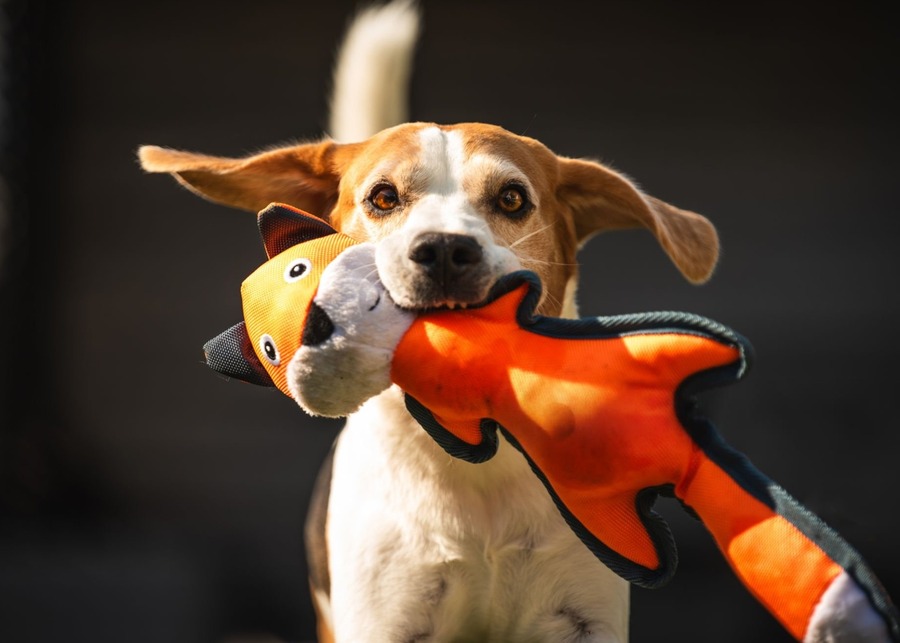That high-pitched squeak drives your dog wild, but why? This primal reaction is often a mystery, leaving you wondering if it’s just play or something deeper.
The squeaky sound in a dog toy mimics the sound of small prey, tapping into a dog’s natural prey drive. This instinctual reaction provides mental stimulation, a sense of reward, and satisfies a deep-seated behavioral need inherited from their hunting ancestors, making the toy incredibly engaging.
This guide will take you on a journey deep inside the world of squeaky toys. We will explore everything from the psychology behind your dog’s obsession to the critical business decisions involved in sourcing safe, high-quality toys for your own brand. We’ll cover the science, the safety, and the strategy, giving you all the information you need.
Why Do Dogs Go Crazy for Squeaky Toy Sounds?
You squeeze a new plush toy, and the first sharp "squeak" cuts through the air. In that instant, something primal awakens inside your dog, and they’re completely captivated.
Dogs go crazy for squeaky sounds because it triggers their prey drive. The high-pitched noise sounds like a small, frightened animal, which makes the dog want to "hunt" the toy. This interaction is fun, rewarding, and mentally stimulating for them.
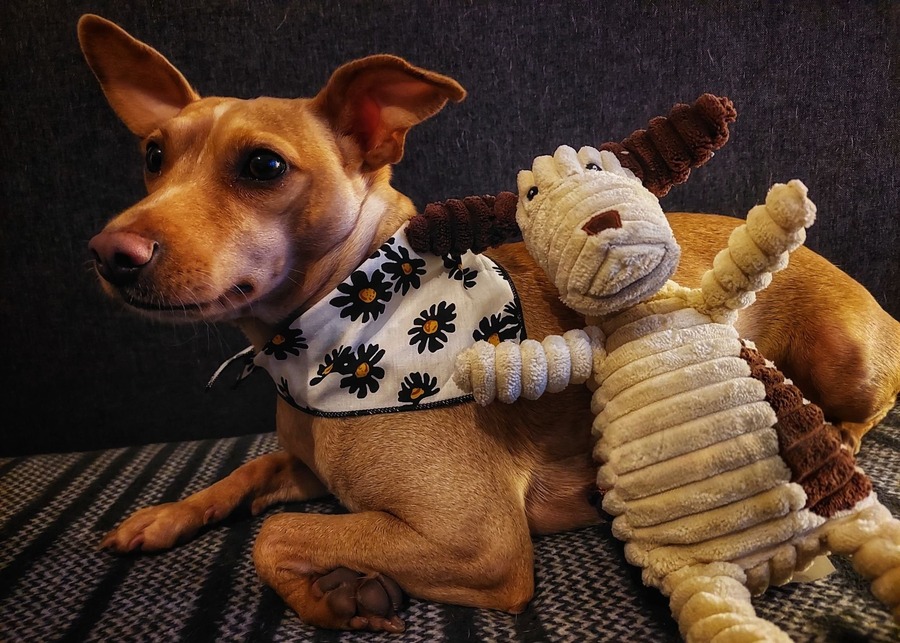
When your dog hears that squeak, it’s not a quirk; it’s a sign of a healthy, engaged mind. This reaction is built on a few key principles that every pet brand owner should understand.
- The Prey Drive Connection: The core reason is instinct. The high-frequency sound is remarkably similar to that of a small rodent or bird in distress. For your dog, the toy becomes a stand-in for prey, and the act of making it squeak is a successful "hunt."
- The Instant Reward Mechanism: Every time the dog bites down and produces a squeak, their brain gets a little hit of dopamine. The sound provides immediate auditory feedback that says, "You did it!" This self-rewarding loop makes them want to play again and again.
- The Novelty and Engagement Factor: A silent toy is just an object. A squeaky toy is an interactive partner. The sound breaks up monotony and keeps the dog’s mind engaged, making it a powerful tool against boredom.
Understanding this isn’t just about knowing dogs better; it’s about recognizing the power of a well-made toy.
Is the Squeaky Sound Tapping into a Dog’s Prey Drive?
You see the focused look in your dog’s eyes when they hear that squeak. Is this just fun, or is it a direct line to their inner wolf?
Yes, the squeak is a powerful trigger for a dog’s prey drive. It’s an "ancestor’s echo," a sound that mimics the distress call of small prey animals. This activates a deep-seated, instinctual sequence of hunting behaviors in most dogs.
This isn’t just a fun fact; it’s the science behind the squeak and it has major implications for product design. When a toy is designed to imitate prey, it must be able to withstand the "hunt" it’s designed to provoke. The dog isn’t just gently playing; in its mind, it’s capturing and subduing its prize. This is why durability and quality are not just features—they are essential requirements. A toy that falls apart during this instinctual play fails at its fundamental purpose and can even become dangerous. This is the first seed of a crucial business principle: if you sell a toy that taps into a primal instinct, you have a responsibility to ensure it’s built to handle that instinct safely.
Can Squeaky Toy Sounds Be Bad or Harmful for Some Dogs?
That intense focus on a squeaky toy can sometimes feel a bit obsessive. As a responsible owner or brand, it’s natural to wonder if this behavior can cross a line.
The sound itself is rarely harmful. The real danger comes from poorly constructed toys that can be torn apart, creating a choking hazard from the squeaker or stuffing. In very rare cases, the sound can encourage obsessive behaviors in certain dogs.
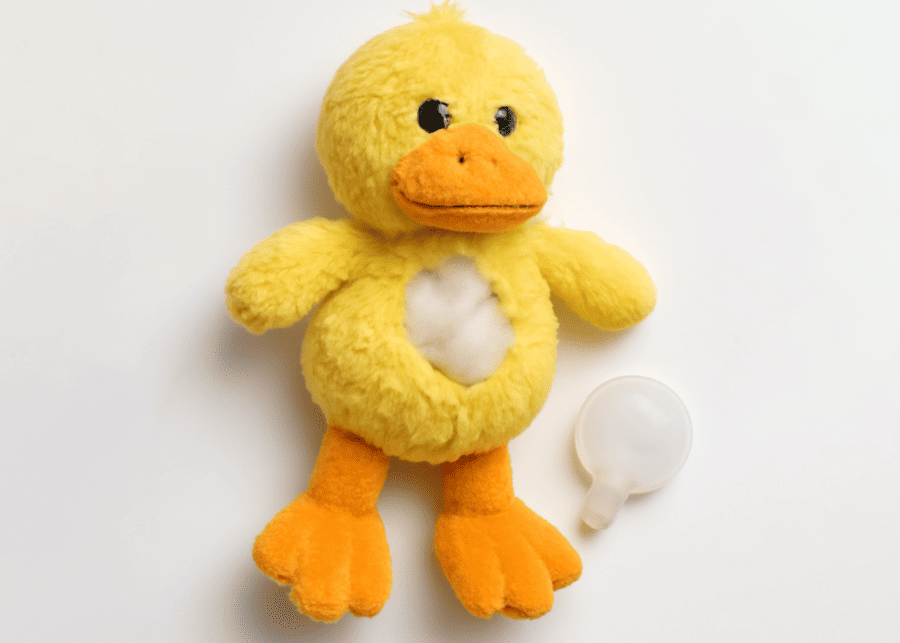
Let’s be direct and honest about the risks, because trust is built on transparency. While the sound can, in a small number of dogs, lead to resource guarding or compulsive chewing, this is the exception, not the rule. The far more common and serious risk is physical, not psychological.
The danger almost never comes from the sound itself, but from the quality of the toy producing it.
| Risk Factor | Root Cause | How to Mitigate |
|---|---|---|
| Choking Hazard | Poor construction, weak seams, easily accessible squeaker. | Sourcing toys with reinforced stitching and securely embedded squeakers. |
| Ingestion | Low-quality materials that shred easily, small parts breaking off. | Using durable, non-toxic fabrics and plastics that resist tearing. |
| Obsessive Behavior | Can be triggered in dogs with high prey drive or anxiety. | Recommending supervised play and promoting toys as tools for interactive fun. |
This insight shifts the focus from a behavioral problem to a manufacturing challenge. As a brand, you can’t control a dog’s personality, but you can absolutely control the quality and safety of the products you sell.
Are squeaky toys mentally stimulating for dogs?
Is a squeaky toy just a simple distraction, or does it offer something more for a dog’s cognitive health?
Absolutely. Squeaky toys are excellent tools for mental stimulation and enrichment. They prevent boredom and anxiety by engaging a dog’s mind in a puzzle: "How do I make the sound happen again?" This problem-solving process is highly rewarding.
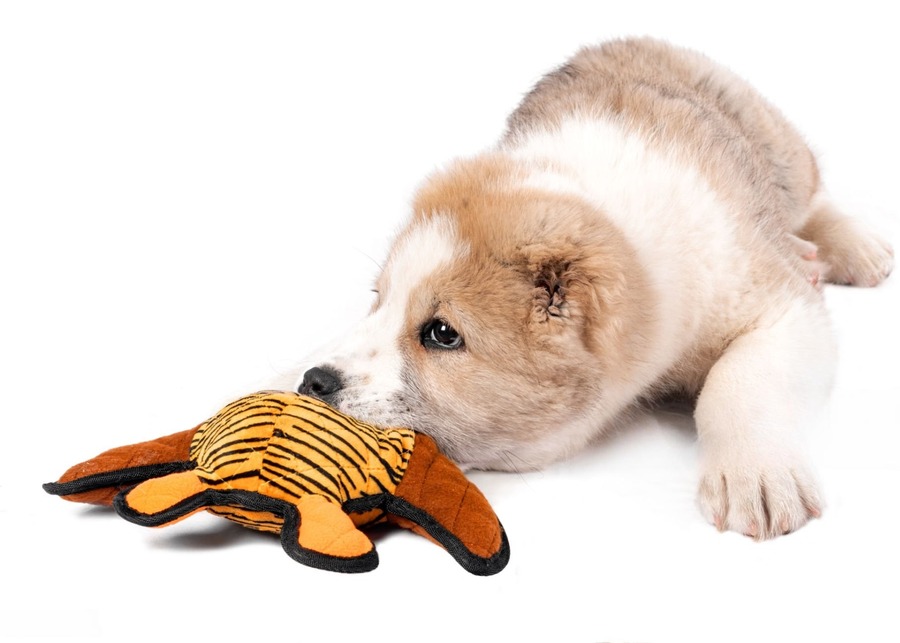
We need to elevate the squeaky toy from a simple "thing to chew" to a "cognitive tool." In the world of animal care, this is called enrichment. It’s the process of creating a stimulating environment to prevent the stress and anxiety that comes from boredom. A squeaky toy is a perfect enrichment item.
But not all squeaky toys are created equal in this regard. This is where thoughtful design comes in. The mental stimulation can be directly linked to the product’s features:
- Sound Variety: Does the toy have one squeaker or multiple squeakers with different tones? A multi-sound toy creates a more complex and engaging puzzle.
- Material and Texture: A toy with varied textures encourages a dog to explore it with their mouth in different ways, keeping their brain active.
- Squeaker Placement: Is the squeaker easy to find, or does the dog have to work a bit to locate it? A hidden squeaker encourages problem-solving.
This perspective provides a clear justification for higher-quality, better-designed toys. You aren’t just selling a toy; you’re selling a solution to boredom and a tool for a healthier, happier dog.
How is the Squeaky Sound Actually Made Inside a Toy?
We’ve talked about the "why," but what about the "how"? Let’s pull back the curtain and look at the simple but clever mechanics inside.
A squeaker is the "heart" of the toy. It’s a small plastic component, usually a bellows with a reed. When the dog bites down, air is forced out through the reed, causing it to vibrate and create the classic high-pitched squeak.
From a manufacturer’s perspective, this simple mechanism is a point of critical quality control. It’s more than just a piece of plastic; it is the engine of the entire play experience. To create a reliable squeak, you need two things: consistent airflow and a durable housing. The plastic must be flexible enough to be compressed thousands of times but strong enough not to crack under pressure. The reed must be precisely calibrated to produce a consistent sound. If the squeaker fails, the toy loses its primary interactive feature. By explaining this technical side, we demystify the product and showcase our expertise. We don’t just source toys; we understand them from the inside out.
What Are the Different Types of Dog Toy Squeakers?
A squeak isn’t just a squeak. For a brand owner, understanding the different types of squeakers is like a chef knowing their spices. It’s a menu of possibilities for creating a unique product.
Squeakers come in many shapes and sizes, each creating a different sound experience. Common types include standard round squeakers, longer tube squeakers, and low-frequency "grunters." This variety allows for tailored toy design based on dog size and desired play style.
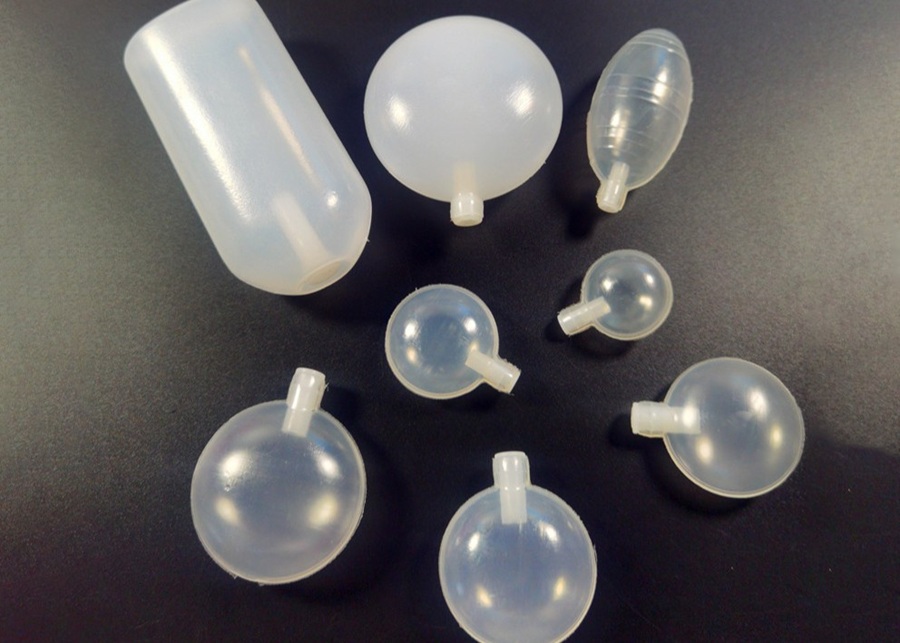
Presenting these options as a simple parts list is a missed opportunity. Instead, we should frame this as a brand differentiation toolbox. Each squeaker type creates a distinct experience and can be used to target a specific market segment.
Here’s a look at the "possibility menu" we offer our clients:
| Squeaker Type | Sound Profile | Best For… | Brand Angle |
|---|---|---|---|
| Round Bellows | Classic, high-pitched "squeak." | Small to medium dogs, classic plush toys. | The familiar, irresistible sound that every dog loves. |
| Tube Squeaker | Can be long, often squeaks on both inhale and exhale. | Long-bodied toys, creating multiple sound zones. | A more interactive toy that keeps making noise as the dog plays. |
| Grunter Squeaker | Low-pitched, guttural "grunt." | Larger dogs, toys designed to mimic larger prey. | A unique sound that stands out from the competition and appeals to big chewers. |
| Multi-Sound Unit | Combines a squeaker with crinkle material or a rattle. | Enrichment toys, puzzle toys. | A premium, multi-sensory experience that provides maximum stimulation. |
By understanding these options, you can move beyond a generic squeaky toy and start designing a product with a specific purpose and appeal.
Can a Toy’s Squeak Be Customized for My Brand?
This is where things get really exciting for brand builders. Can you go beyond a standard squeak and create something truly unique?
Yes, a toy’s squeak can absolutely be customized. This is a powerful ODM (Original Design Manufacturing) service that allows you to create a unique "sound signature" for your brand, turning a simple toy into a memorable brand extension.
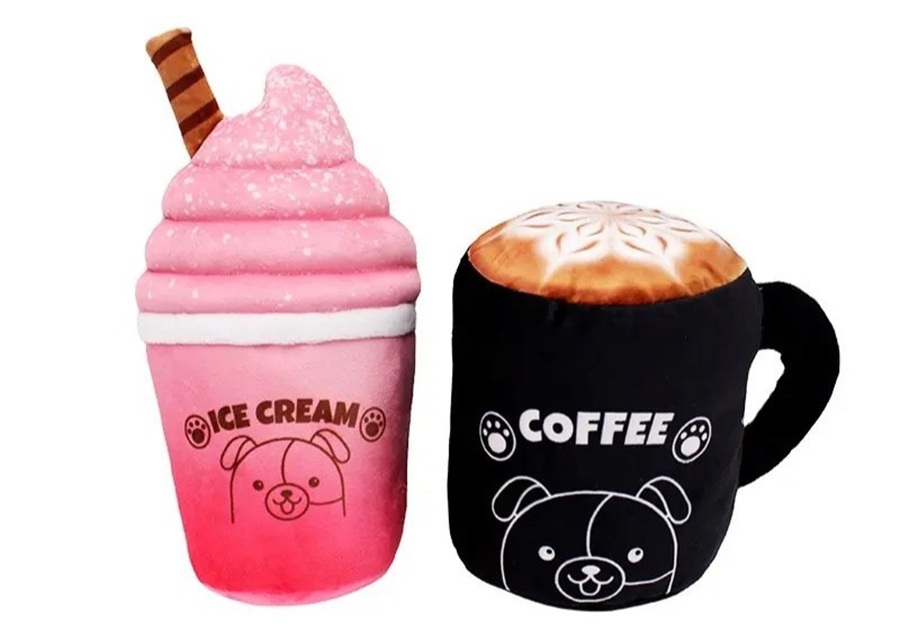
Answering "yes" is not enough; we must frame this as a strategic advantage. This isn’t just about changing a sound; it’s about building your brand’s identity.
Let me share a story. We worked with a client, let’s call her Maria, who owns a successful chain of pet-friendly coffee shops. She noticed dogs getting restless while their owners enjoyed their lattes. She came to us with an idea: could we create a plush toy shaped like a coffee cup? We took it a step further. Instead of a standard squeak, our design team worked to develop a unique, lower-pitched "percolating" sound.
The result was a huge success. The toy was not only a fun distraction for the dogs in her cafes but also a perfect piece of merchandise. Customers loved the clever branding, and it created an entirely new revenue stream for her business. This story makes the abstract concept of ODM concrete, exciting, and, most importantly, profitable. It shows that a custom sound isn’t a gimmick; it’s a smart business move.
How Can I Guarantee the Squeakers in My Toys Are Safe?
As a business owner, a pet owner’s worry becomes your commercial responsibility. A product failure isn’t just a return; it’s a risk to your customers and your brand’s reputation.
Guaranteeing safety means moving beyond the purchase order. You must partner with a manufacturer that has rigorous, verifiable quality control processes for materials, structural integrity, and durability testing. The focus must be on preventing hazards before they are ever produced.
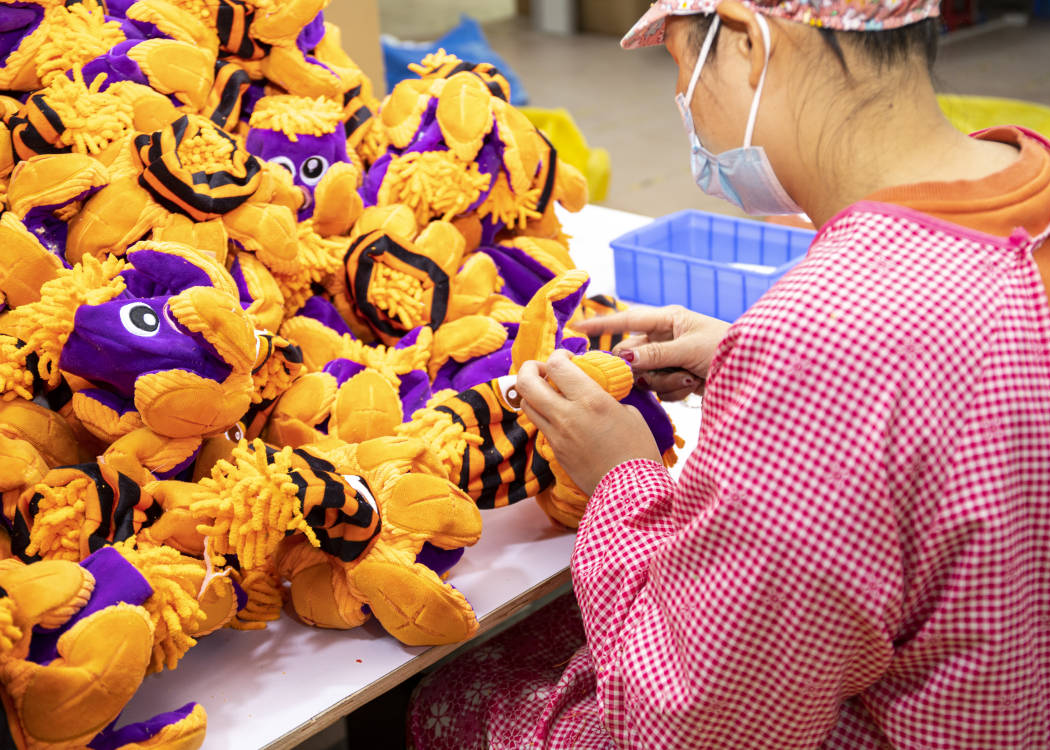
This section is about protecting your brand. We provide our partners with a clear, actionable framework for safety assurance, which is a direct reflection of our own internal processes. When you source from us, this is the quality control you can expect.
The Preeminent Safety Checklist:
-
Material Safety & Traceability:
- What we do: We use only non-toxic, BPA-free plastics for our squeakers. We maintain full traceability of our raw materials, so we know exactly what goes into your product and where it came from.
- Why it matters: This prevents dogs from being exposed to harmful chemicals and ensures material consistency across every batch.
-
Structural Integrity & Embedding:
- What we do: Squeakers are securely embedded within dedicated fabric pouches inside the toy, far from a single seam. We use reinforced stitching to ensure the toy’s shell is not easily breached.
- Why it matters: This makes it extremely difficult for a dog to access and swallow the squeaker, which is the single biggest safety risk.
-
Durability & Stress Testing:
- What we do: We perform bite-force and pull tests on our toy designs to identify weak points. We test the squeaker itself to ensure it won’t crack or shatter under the repeated pressure of chewing.
- Why it matters: This ensures the toy can stand up to the vigorous play it’s designed to encourage, protecting both the pet and your brand’s reputation.
What Should I Look For in a Pet Toy Manufacturer?
Choosing a manufacturing partner is one of the most critical decisions you’ll make. The right partner is more than a supplier; they are an extension of your business.
Look for a partner, not just a factory. The ideal manufacturer has end-to-end capabilities, from design to mass production. They should have a transparent quality control process and the ability to integrate a diverse supply chain for one-stop sourcing.
At this point, I’m acting as your consultant. Instead of just saying "choose us," I want to empower you with the criteria to judge any manufacturer. Naturally, these criteria highlight the very strengths we’ve built our business on.
Hallmarks of a Great Manufacturing Partner:
- Comprehensive Capabilities: Do they offer a full suite of services? A partner who can take you from a simple idea sketch all the way to mass production (ODM) or customize existing products with your branding (OEM) is invaluable. This saves you the immense headache of coordinating between separate design firms, prototyping labs, and factories.
- Proven Supply Chain Integration: Many brands need more than just one type of product. Like our client Judy from Germany, you might need toys, bowls, and beds. A partner with a robust, integrated supply chain can act as your central procurement hub. This one-stop sourcing service drastically cuts down on communication time, simplifies logistics, and lowers shipping costs.
- Transparent Quality Control: They should be able to not just tell you, but show you their quality control processes. Ask for documentation, testing reports, and pre-shipment photos. Transparency is the bedrock of trust.
- Expert Communication: Your partner should be a proactive communicator who understands your market and your goals. They should offer expert advice, not just wait for instructions.
What Critical Questions Should I Ask a Potential Supplier?
You’re ready to start the conversation. To ensure you find a truly capable partner, you need to ask the right questions—the kind of expert-level questions that a novice buyer might not think of.
Arm yourself with specific, probing questions that test a supplier’s processes, transparency, and problem-solving skills. Their ability to answer confidently will reveal their true level of expertise and reliability. This is your final due diligence step.
Here is a high-value list of questions to ask any potential supplier. These questions are designed to move past the sales pitch and get to the core of their operational capabilities.
- "What is your raw material traceability process? Can you show me how you track materials from source to final product?"
- This tests their commitment to safety and quality control at the most fundamental level.
- "For a consolidated one-stop sourcing order with multiple product categories, how do you verify the quality control for items you don’t manufacture in-house?"
- This tests the true strength and reliability of their supply chain integration.
- "Can you walk me through your ODM process, from concept to the pre-production sample?"
- This tests their design and development capabilities and their communication process.
- "Please show me an example of a durability testing report for a plush toy similar to what I need."
- This tests whether their quality claims are backed by actual data.
- "How do you optimize packaging to reduce shipping volume and cost? Can you provide a case study?"
- This tests their understanding of logistics and their commitment to saving you money.
At Preeminent, our business is built on being ready with the answers before our clients even think to ask the questions.
Conclusion
From dog psychology to brand strategy, the right squeak matters. We are here to help you create safe, engaging toys that build your brand and delight pets.

